Basic definition of the Chin series within the Princeton offense
The Chin series features a unique set of actions within the Princeton offense that emphasize creating high percentage scoring opportunities near the basket or near perimeter areas of the court, primarily via certain basketball screens.
Also, the Chin series is generally most effective for positionless teams in which all five players can interchange roles or at the very least, four players can switch roles while one player remains in the same role, mainly operating from the high post area of the court.
Nevertheless, the Chin series and by extension, the overall Princeton offense, which includes other sets such as the Low Post series and the Point series, could be considered by traditional teams with at least two low post players or undersized teams with less than two low post players.
General rules for the Chin series
Maintain proper spacing
Players should always strive to maintain proper spacing on the court when executing the Chin series.
Generally speaking, to maintain an adequate amount of spacing, players should be about 12 to 15 feet from adjacent teammates.
Good spacing can make it more challenging for the defensive team to effectively guard against offensive actions within the Chin series, which could also lead to various scoring possibilities.
The diagram below shows the primary areas of the court that players could occupy while maintaining good spacing during the implementation of the Chin Series.
Example diagram of primary court areas for Chin series
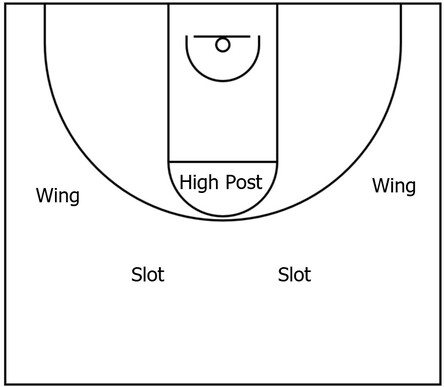
Generally speaking, the primary areas of the court that players could occupy within the Chin series include the slots, the wings, and the high post area, which also includes the elbows as well.
Slots
The slots, sometimes referred to as the lane line extended areas, are the areas behind the three-point line that are above and between the top and the wings.
Players will typically occupy the slot areas during initial sets to start the Chin series and/or to perform various offensive actions such as cutting to the basket after receiving a back screen from a teammate.
Wings
The wings comprise areas behind the three-point line that are adjacent to the nearest sideline, which is generally at or above the free throw line extended and typically below the slots.
Players will usually fill the wing areas during the initial setup to start the Chin offense and/or to execute certain actions such as passing the ball to open teammates.
High post
The high post is the general area that covers the free throw line from one edge to the other as well as the adjacent area that is between the free throw line and the top of the three-point line.
Furthermore, the edges of the free throw line are typically known as the high post elbows or simply, the elbow areas of the court.
Within the Chin series, one player will usually fill the high post, mainly to set screens, while the other players fill the other aforementioned areas.
Additional secondary areas
What’s more, in certain instances, players might fill additional secondary areas such as the top, the low post areas, and the corners.
The top, sometimes referred to as the top of the key, is the general area located behind the three-point line in the middle of the offensive team’s frontcourt.
The low post areas are slightly above the basket and just outside of the lane lines, which are borders for the lane.
In relation to the Chin series, one particular player could fill the low post area during the initial setup before moving to the high post area during the primary offensive actions.
Make crisp passes
Players should make crisp passes to teammates that are swift but easy to catch. In essence, the ball should be thrown to a teammate’s chest area or as a lead pass when a teammate is cutting to the basket.
This is especially important to consider when passing from the slot area to the wing area, which typically leads to offensive actions such as cutting and screening.
Moreover, the recipient of a pass should try to catch the ball with both hands while simultaneously landing on two feet when possible.
When players catch with two hands, it is generally easier to secure the ball away from the defense and the player is more capable of dribbling, shooting, or passing via the triple threat position.
In addition, when players catch and land on two feet, a pivot foot has not been established at that moment which also makes it more effective to utilize the triple threat.
Furthermore, landing on two feet could potentially lower the chances of players accidentally taking too many steps, which can lead to a traveling violation and subsequent turnover.
Set good screens
Players should set good basketball screens while executing the Chin series. This will primarily apply to the high post player but in other instances, it could apply to other players as well.
To set a good screen, players should position their feet about shoulder-width apart with their back straightened and knees slightly bent to form a good base.
Additionally, players should place their hands across their chest or across their lap and have their elbows kept within their own space.
In other words, a player’s elbows should not extend beyond their own sides. Also, players could use an open hand or closed fist when placing their hands across their body.
Backdoor cut when denied
The Princeton offense in general allows players without possession of the basketball to perform a backdoor cut when the opportunity presents itself.
Within the Chin series, this is also feasible, especially when an opponent attempts to play denial defense by placing a hand in the passing lane that is between the player in possession of the ball and an adjacent player who could be a recipient of that pass.
Essentially, the off-ball player can try to get open by way of an initial quick step towards the offensive teammate in possession of the ball, followed by an immediate cut to the basket to complete the backdoor cut action.
Main components of the Chin series
The main components of the Chin series consists of a back screen, a flare screen, as well as a continuity pattern, if necessary, to generate scoring possibilities.
The diagrams below showcase examples of these concepts.
What’s more, the offensive players and their defensive counterparts are not currently represented by any relevant basketball role or position.
Instead, for the time being, the offensive players are simply denoted as 1 through 5 while the defensive players are indicated as X1 through X5, primarily for demonstrative purposes.
Back screen
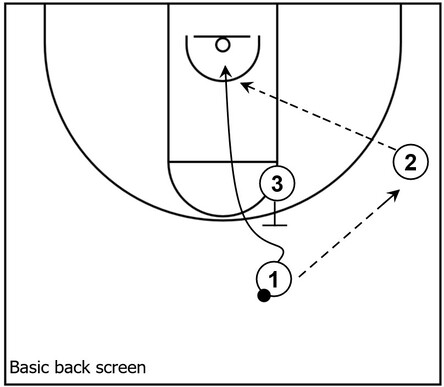
A back screen occurs when one offensive player is able to set a screen behind a defender who is guarding a second offensive player.
From there, the second offensive player could then use that screen to get open, particularly near the basket.
For the diagram, 2 receives the ball from 1, represented by the dotted arrow.
Next, 1 cuts to the basket via the back screen set by 3.
Afterwards, 1 receives the ball from 2 and scores by way of a layup.
Flare screen
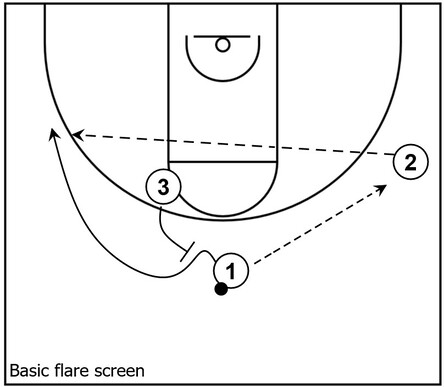
A flare screen occurs when one offensive player cuts away from the basketball to use a screen that is set by a second offensive player and afterwards, the first offensive player could then receive the ball, particularly near the perimeter areas of the court.
On the adjacent diagram above, 2 receives the ball from 1 and from there, 1 cuts away to the left side wing via the flare screen set by 3.
After that, 1 receives the ball from 2 via a skip pass and takes the open jump shot.
Continuity pattern
A continuity pattern consists of various cuts, screens, passes, or dribble actions executed in a continuous manner on both sides of the court to generate the highest quality scoring opportunity.
The diagrams below within this subsection demonstrate a basic continuity pattern, which also features back screens and flare screens.
Continuity Example Part 1: Back screen
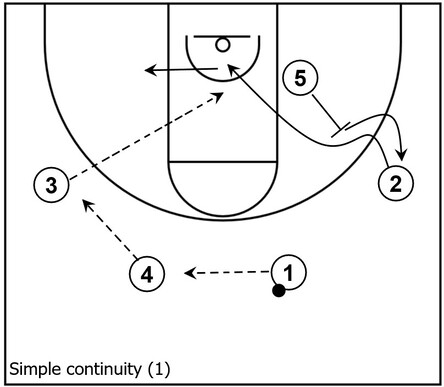
To begin, 4 receives the ball from 1 and then 3 receives it from 4.
As that happens, 2 cuts to the basket via the angle back screen set by 5.
If 2 is open after the cut, then 2 could receive the ball from 3 and score via a swift layup.
Otherwise, 2 could move out the lane and occupy the left side low post area for the time being.
5 could also fill the vacant right side wing as well.
Continuity Example Part 2: Back screen and flare screen
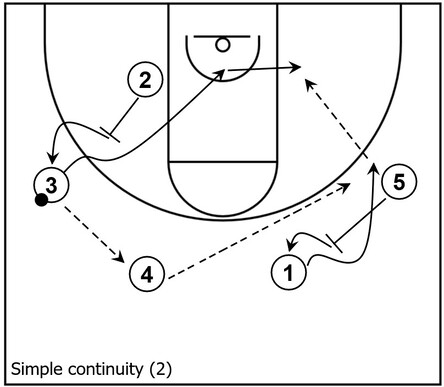
Next, 3 can reverse the ball to 4 and as that occurs, 1 can cut to the right side wing via the flare screen set by 5.
Following that, 1 could receive the ball via a skip pass from 4 and take the jump shot if open.
However, if 1 is not open, then 3 could cut to the rim via the back screen st by 2, receive the ball from 1, and score by way of a layup.
Additionally, if 3 is not open, then 3 could occupy the right side low post block while 2 fills the left side wing area.
Furthermore, 5 could fill right slot area following that flare screen action as well.
Continuity Example Part 3: Back screen and flare screen on opposite sides
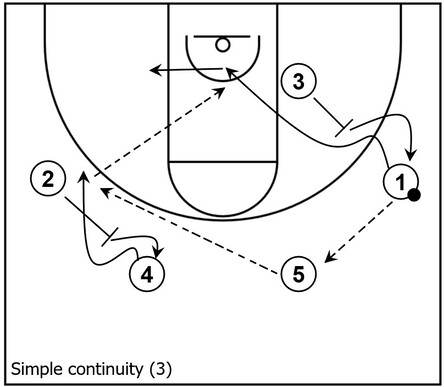
This portion features the continuity of the back screen and flare screen actions executed on opposite sides of the floor.
Basically, 5 can receive the ball from 1 if the jump shot was not available.
Next, 4 cuts to the left side wing via the flare screen set by 2 and has the option to take the open jump shot.
However, if 4 does not take the shot, then 1 could cut to the rim via the back screen set by 3, receive the ball from 4, and score via a layup.
Otherwise, 1 moves to the left side low post area, 2 fills the left slot, and 3 fills the right side wing area.
Following that, the continuity pattern could be ran on the opposite side of the floor once again and this could keep going until the team finds the best scoring opportunity.
Initial setup for the Chin series
Within the Chin series, the 2-2-1 alignment is typically the most common initial setup to begin the offense.
The diagram below demonstrates this concept with an example.
Furthermore, in reference to the diagram within this section as well as other diagrams within subsequent sections, each offensive player is indicated by a number that generally represents one of the standard basketball positions while each defensive player has a correlated number to a similar position that is shown alongside the letter X.
Essentially, 1 and X1 are the offensive and defensive point guards, respectively.
2 and X2 are the offensive and defensive shooting guards, respectively.
3 and X3 are the offensive and defensive small forwards, respectively.
4 and X4 are the offensive and defensive power forwards respectively.
Lastly, 5 and X5 are the offensive and defensive centers, respectively.
That is to say, 1 and 2 are the guards. 3 and 4 are the forwards. 5 is a traditional low post player.
Additionally for this section as well as later sections, players will usually remain in these particular roles unless stated otherwise.
2-2-1 alignment
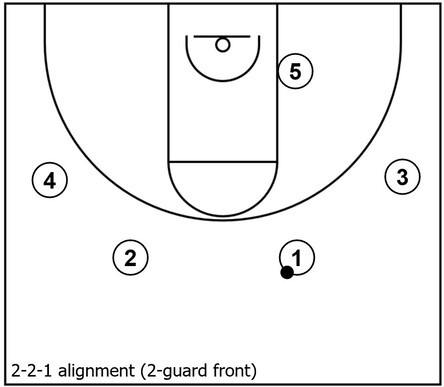
This is an example of the initial 2-2-1 alignment for the Chin series.
Moreover, to give more clarity on the naming convention for the 2-2-1 alignment, the digits that are to the left or right of a dash (-) represents the number of offensive players located within a general region of the court.
What’s more, if a formation or alignment contains only one dash, then the number of players to the left of the dash would represent the front or top region while the number of players to the right of the dash would represent the back or bottom region.
In a similar fashion, if a formation or alignment contains two dashes, then the number of players to the leftmost of the dashes would represent the front or top region, the number of players in between the leftmost and rightmost dashes would represent the middle region, and the number of players to the rightmost of the dashes would represent the back or bottom region.
This could also apply to other formations or alignments as well.
So, with all that said, for the case of the 2-2-1 alignment, this means that there are two offensive players located at the front region (i.e. the slot areas), two offensive players located in the middle region (i.e. the wing areas), and one offensive player located in the back region (i.e. the low post area).
To be even more specific for this case, there are two guards (1 and 2) in the slots, two forwards (3 and 4) on the wings, and one traditional low post player (5) who begins near the low post area on the strong side of the court.
In addition to that, this particular set could be generally referred to as a 2-guard front as well because there are specifically two guards located in the front region of the alignment/formation.
Examples of primary actions within the Chin series
Part 1: Dribble handoff and interchange
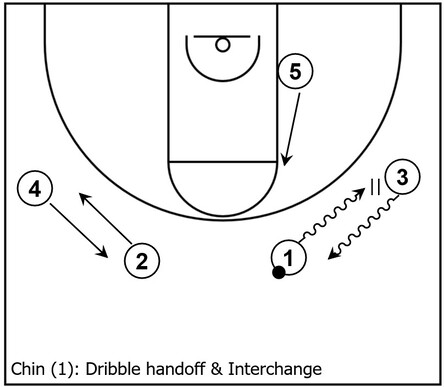
To begin the primary action for the Chin series, 1 and 3 carry out a dribble handoff on the right side of the court, indicated by the arrows with wavy lines in addition to the double pipe symbol.
At the same time, 2 and 4 interchange spots on the weak side of the floor opposite the ball.
Additionally, 5 moves up toward the right side high post area from the low post area.
Part 2: Back screen
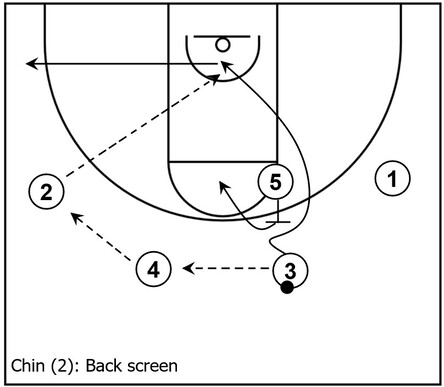
Next, 4 receives the ball from 3 via a slot to slot pass and afterwards, 2 receives the ball from 4 via a slot to wing pass.
Once 2 gains possession of the ball, 3 immediately cuts to the basket via a back screen set by 5.
Following that, 3 could receive the ball from 2 and score near the rim.
Otherwise, if 3 is not open, then 3 could cut through to the left side corner for the time being while 5 moves to the middle high post area.
Part 3: Flare screen
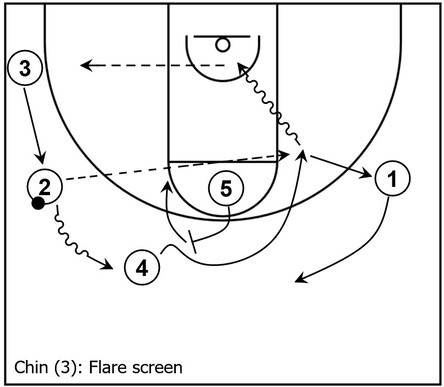
After 3 fills the corner, 4 cuts toward the right side high post elbow area via a flare screen set by 5.
Following that, 4 could receive the ball via a skip pass from 2 and then take the open mid-range jump shot.
Alternatively, 4 could also attack the rim for a layup or throw a potential kick pass to 3 who could shoot the three-point jump shot.
However, if 4 does not receive the ball, then 2 could dribble up towards the left slot while 1 cuts to the right slot.
3 could also occupy the vacant left side wing while 4 fills the empty right side wing.
5 should move towards the left elbow area as well.
Part 4: Continuity back screen
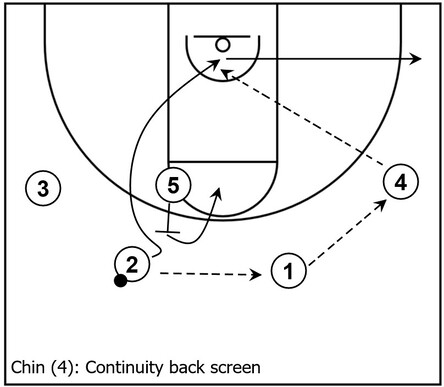
At this point, the players are in position to start the continuity pattern of the Chin offense.
To begin, 1 receives the ball from 2 via a slot to slot pass and then 4 receives the ball from 1 via a slot to wing pass.
Next, 2 cuts to the basket via the back screen set by 5 and could receive the ball from 4, which could lead to a scoring opportunity at the rim.
Otherwise, 2 cuts through to the right side corner while 5 moves to the middle high post area.
Part 5: Continuity flare screen
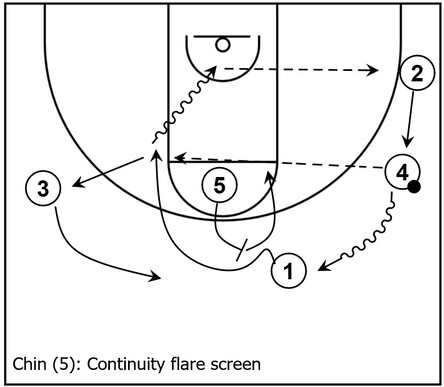
Next, 1 cuts away to the left side elbow area via the flare screen set by 5 and could receive the ball from 4 via the skip pass.
From there, 1 could take the mid-range jump shot or attack the rim to score a layup or throw a kick pass with 2 as the receiver who could take the three-point jump shot if open.
On the other hand, if 1 does not receive the ball after the flare screen action, then 4 could dribble towards the right slot while 3 cuts to the left slot.
In addition, 2 could occupy the empty right side wing while 1 fills the vacant left side wing.
Finally, 5 moves to the right side elbow area and then the continuity could be executed once more.
Examples of secondary actions for the Chin series
These are examples of secondary actions for the Chin series that could be used as counters when the defense attempts to hinder or totally prevent certain aspects of the primary actions.
More specifically, these examples show secondary actions that could be implemented as counters when a defender of the opposing team tries to deny and take away the slot to wing pass or the slot to slot pass.
What’s more, there is a counter that could be considered when a defender sags in the paint to mitigate the effectiveness of the back screen.
Counter vs. wing denial
Here is an example of a counter that could be implemented against denial defense near the wing of the court featuring a backdoor cut and back screen action.
It should be noted as well that the initial dribble handoff action and interchange has already occurred for this scenario.
Part 1: Backdoor cut
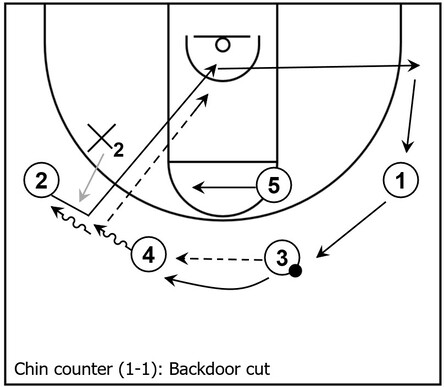
To start, 4 receives the ball from 3 and would like to pass to the wing with 2 as the recipient.
However, X2 is denying the pass, represented by the gray arrow.
Therefore, 4 takes one dribble towards the adjacent wing which signals an automatic backdoor cut from 2.
Afterwards, 4 could throw the ball, particularly by way of a bounce pass, with 2 as the receiver who could then score at the rim if feasible.
Nonetheless, if 4 does not pass the ball, then 2 should continue cutting through to the right side corner while 4 keeps dribbling to the left side wing.
Also, 3 should slide over to the left slot while 1 fills the vacant right slot.
Furthermore, 2 should occupy the empty right side wing while 5 slides over to the left side elbow area.
Part 2: Back screen
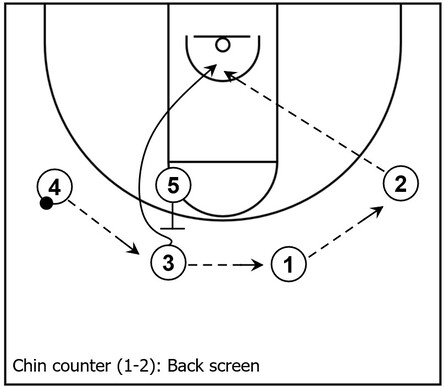
After the backdoor cut counter option completes, the offensive team can initiate the regular Chin action again.
On the diagram, 3 receives the ball from 4 via the wing to slot pass, 1 receives it from 3 via the slot to slot pass, and 2 receives it from 1 via the slot to wing pass.
Following the reversal action, 3 cuts to the basket by way of the back screen set by 5, receives the ball from 2, and scores via a layup or slam dunk.
From this point, it is also possible to execute the flare screen portion of Chin as well as the continuity pattern, although this particular diagram does not demonstrate those actions.
Counter vs. slot denial
This is an example of a counter that could be implemented against denial defense that attempts to prevent a slot to slot pass.
Part 1: UCLA action
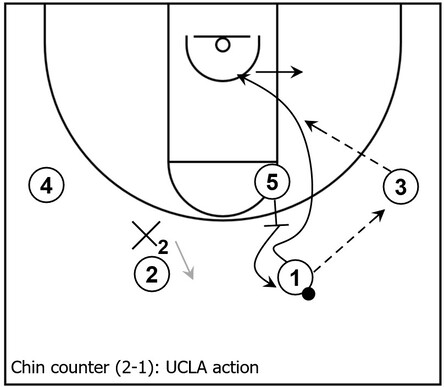
During the initial action, 1 would like to execute the slot to slot pass with 2 as the recipient.
However, X2 denies that pass, represented by the gray arrow.
As a result, 1 counters by passing the ball to 3 via the slot to wing pass.
Next, 1 and 5 execute action derived from the UCLA offense, which consists of a high post back screen and cut from the slot respectively.
Afterwards, 1 could receive the ball from 3 and score at the rim via a layup.
Otherwise, 1 could step out of the lane area and occupy the right side low post area while 5 fills the vacant right slot.
Part 2: Down screen and flare screen
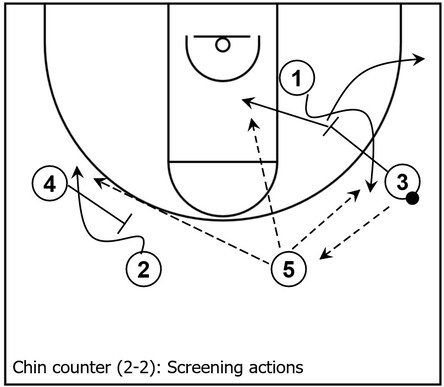
Next, 5 receives the ball from 3 and following that, 1 cuts to the right side wing via a down screen set by 3.
Moreover, at the same time, 2 cuts to the left side wing via a flare screen set by 4.
From there, 5 could pass the ball with 1 or 2 as potential receivers for jump shot opportunities.
Additionally, 3 could slip to the basket during the screening action, especially if defenders were to switch assignments.
Otherwise, 3 could simply cut to the right side corner following the down screen action.
Part 3: Chin reset
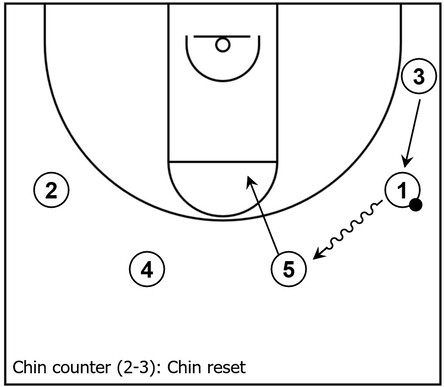
Next, 1 dribbles toward the right slot area while 5 cuts to the right side high post and 3 fills the empty right side wing.
At this point, the players are ready to execute Chin once again.
Counter vs. sagging defense
This is an example of a counter that could be applied when the screener’s defender sags into the lane to prevent the possible layup from the back screen action.
Additionally, the initial dribble handoff action and interchange have already occurred, similar to a previous example.
Part 1: Rim protector prevents easy layup
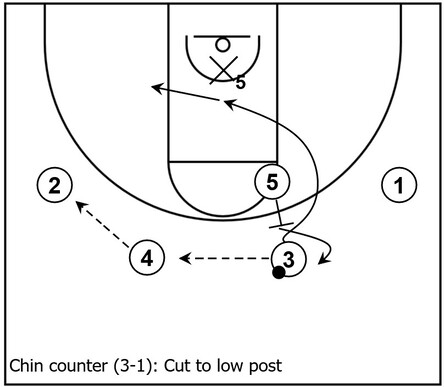
To begin, 4 receives the ball from 3 and afterwards, 2 receives it from 2.
Following that, 3 cuts to the basket via the back screen of 5.
However, X5 who is initially guarding 5 sags into the lane to prevent the easy high percentage field goal attempt, which in this case, would be a layup or dunk.
Therefore, since the scoring opportunity is not there, 3 simply cuts to the left side low post area for the time being.
Part 2: Elevator screen
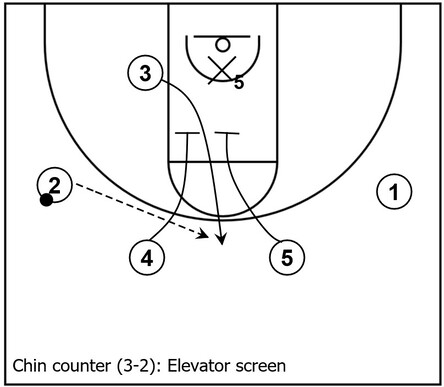
Next, 3 cuts back to the top via the elevator screen set by 4 and 5, receives the ball from 2, and take the three-point shot if open.
Additional resources to potentially learn more about the Chin series
This section contains additional resources that could be potentially useful to learn more about the Chin series of Princeton offense.
NBA Coaches Playbook: Techniques, Tactics, and Teaching Points; Chapter 7, Princeton Offense by Eddie Jordan and Pete Carril
Winning with the Princeton Style Offense by Lee DeForest
How To Run The Princeton Offense Chin Series – YouTube